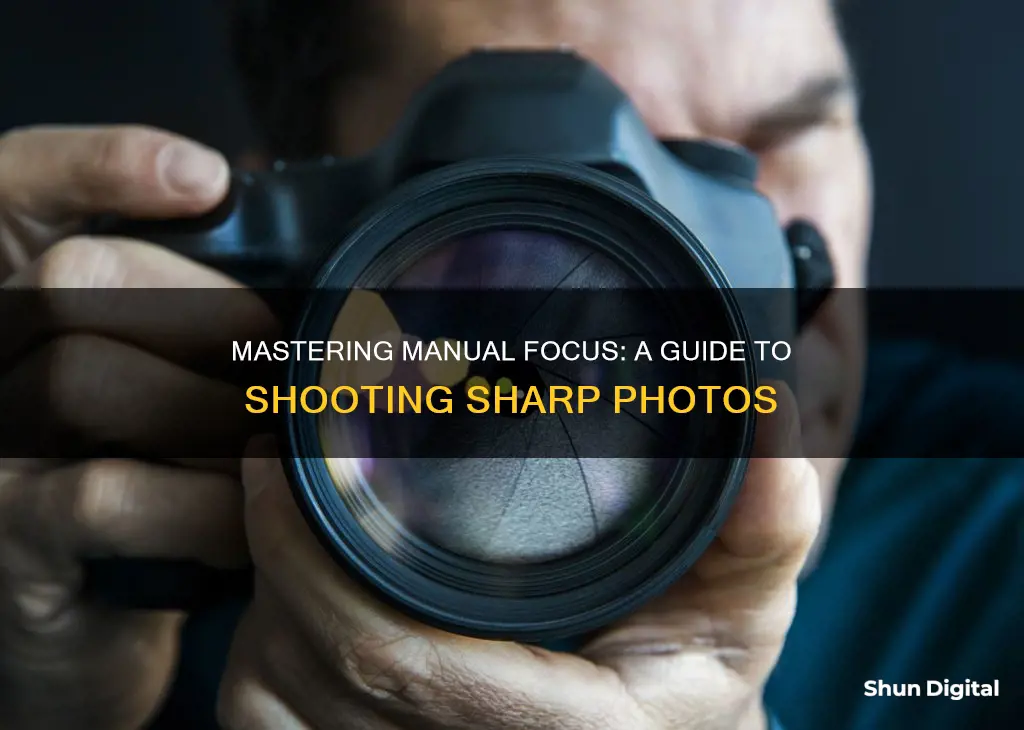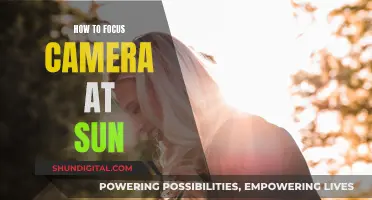
Manual focus is a useful skill to learn for any photographer. While autofocus is a great tool, it can sometimes lock onto the wrong part of a scene or struggle in low-light conditions. In these situations, switching to manual focus can help you get the shot you want.
Manual focus is when you adjust the in-focus region to be closer or further from the camera, usually by rotating the focusing ring on your lens while autofocus is disabled. This gives you, the photographer, full control over what is in focus and what isn't.
Manual focus is particularly useful for certain types of photography, such as macro, low-light, and street photography, where autofocus might struggle. It can also be beneficial when shooting video, as it ensures the focus remains consistent from shot to shot.
While it may seem daunting at first, with practice, you can develop the skill and dexterity needed to master manual focus.
| Characteristics | Values |
|---|---|
| When to use manual focus | Low-light situations, astrophotography, macro photography, low-contrast situations, street photography, landscape photography, hyperfocal distance photography, wide-angle photography, panorama photography, creative effects, sports photography, wildlife photography, bird photography, event photography, car photography |
| How to enable manual focus | Locate the focusing mode switch on your camera or lens and switch to "MF" |
| How to get sharp results with manual focus | Practice, use the diopter adjustment, use a loupe, use the magnifying button to zoom in on your live view screen, use focus peaking |
| Manual focus vs autofocus | Autofocus is useful for moving subjects or fast-paced scenarios |
What You'll Learn

Manual focus in low-light conditions
Manual focus is a great skill to have in your arsenal as a photographer, especially when shooting in low-light conditions. Here are some tips and tricks to help you master manual focusing in challenging lighting situations.
Understand Manual Focus
First, let's understand what manual focus is. Almost all camera lenses have the ability to adjust focus manually. This is done by rotating the focusing ring on your lens while autofocus is disabled, allowing you to adjust the in-focus region closer or further from the camera.
When to Use Manual Focus in Low Light
There are several scenarios where manual focus can be advantageous in low-light conditions:
- Low-light levels: In dimly lit environments, such as a candlelit room or a dark street, autofocus may struggle. Switching to manual focus can be easier than fighting with the autofocus system.
- Astrophotography: This presents one of the most challenging subjects for autofocus due to extremely low light and the need for precise focus. Manual focus, often combined with magnified live view, can be a better choice.
- Action in a specific location: If you know where the action will occur, such as a baseball player sliding into home plate or a bride entering a church, manual focus can ensure your camera is already focused and ready to capture the moment.
- Autofocus confusion: In low-contrast or transparent subjects, autofocus may struggle and get confused. Manual focus can be a better option in these situations, even if it's just a rough adjustment to nudge the focus in the right direction.
Techniques for Manual Focusing in Low Light
- Use a flashlight: Carry a flashlight with you to temporarily illuminate your subject, allowing you to focus more easily. You can then turn off the flashlight and capture the image in the low-light conditions.
- Use the lens distance scale: Some lenses have a distance scale that can help with manual focusing. While these scales may not be extremely precise, they can give you a good starting point. Just remember to stop down a bit to increase the depth of field.
- Focus on something else: If your subject is too far away or difficult to focus on, try focusing on an object that is approximately the same distance away. You can then lock the focus, recompose your shot, and capture the image.
- Use live view and zoom: Many cameras offer live view functionality, which can be helpful in low-light conditions. Zooming in on your subject via live view can help you fine-tune your manual focus and ensure it is sharp.
- Use autofocus assist (AF assist): Some modern speedlights or flash commanders have a built-in "AF assist" red beam. By mounting one of these on your camera's hot shoe, you can project a red beam onto your subject, allowing your lens to acquire focus more easily.
- Use back button focus: Back button focus can be useful in low-light conditions, especially with moving subjects. It allows you to lock focus and then depress the shutter to take the shot, reducing the risk of your camera trying to refocus.
Practice Makes Perfect
Manual focusing in low-light conditions takes practice and a bit of dexterity. The more you familiarise yourself with the process, the more intuitive it will become. So, get out there, experiment, and don't be afraid to make mistakes—that's how we learn!
Reviving Your Camera Battery: Charging from Zero
You may want to see also

Manual focus for macro photography
Manual focus is a valuable skill to learn for any photographer, and it can be especially useful for macro photography. Here are some tips and techniques for achieving sharp focus in your macro shots:
Understanding Depth of Field
Before getting into the specific techniques for manual focus, it's important to understand the concept of depth of field, which is crucial in macro photography. The depth of field refers to the distance between the nearest and farthest objects that are in sharp focus. In macro photography, due to the close-up nature of the shots, the depth of field is very thin, resulting in only a small area of the image being sharply in focus. This can be used creatively to isolate your subject, but it can also be challenging to manage. Adjusting your aperture is one way to control the depth of field, with a smaller aperture (higher f-stop number) resulting in a greater depth of field.
Using a Tripod
A good sturdy tripod is highly recommended for macro photography, especially when shooting in manual focus mode. It helps eliminate camera shake and keeps the camera steady, allowing you to make precise adjustments to your focus. Additionally, a tripod with a reversible centre column can be useful for getting down low or moving in close to your subject.
Focusing Techniques
When focusing manually, it's important to turn the focus ring slowly until your subject reaches its sharpest point of focus. Some photographers recommend going slightly beyond this point and then slowly rolling the focus ring back to confirm the sharpest point. This technique takes practice, and it's important to develop a feel for how much to adjust the focus ring. Additionally, some photographers suggest keeping the focus point fixed and moving the entire camera back and forth to fine-tune the focus, rather than adjusting the focus ring. This method can help eliminate hand movements that can occur when turning the focus ring.
Using Focus Peaking and Other Focusing Aids
Most modern cameras have focusing aids that can be incredibly useful for manual focus in macro photography. One such feature is focus peaking, which overlays coloured lines on the areas of sharpest focus. This helps you visualise the depth of field and ensure that your subject is in focus. Additionally, using the camera's LCD screen instead of the viewfinder can be beneficial as it often provides a zoom function, allowing you to focus with greater accuracy.
Focus Stacking
Focus stacking is an advanced technique that involves taking multiple images with slightly different focus points and then stitching them together in post-processing. This technique allows you to achieve a greater depth of field and have more of your macro subject in focus. Some newer cameras even have built-in focus stacking capabilities, making it easier to achieve sharp results.
Practice and Experimentation
Finally, the key to mastering manual focus in macro photography is to practice and experiment. Get out there and shoot as much as possible, trying different techniques and focusing on various subjects. Over time, you'll develop a feel for manual focus and be able to create stunning macro photographs.
The Evolution of Camera Materials: Past, Present, Future
You may want to see also

Manual focus for shallow depth of field
Shallow depth of field is a technique that can add dimension to your photographs. It is achieved by shooting photographs with a low f-number, or f-stop — from 1.4 to about 5.6 — to let in more light. This puts your plane of focus between a few inches and a few feet.
Manual focus is a great way to achieve a shallow depth of field. Here are some tips to help you master this technique:
- Understand the basics of depth of field: Depth of field refers to the distance between the closest and farthest objects in a photo that appears acceptably sharp. While your camera can only focus sharply on one point, the transition from sharp to unsharp is gradual. The term "acceptably sharp" is subjective and depends on various factors, such as how the image will be viewed and the viewer's eyesight.
- Know the factors that influence depth of field: In addition to the aperture, the distance between the camera and the subject, the focal length of the lens, and the sensor size also affect the depth of field.
- Choose the right equipment: Some lenses, particularly those with fast apertures like f/1.4 and telephoto focal lengths, have very narrow depths of field. This can challenge autofocus systems, so manually focusing may give better results. Additionally, avoid using a wide-angle lens when shooting shallow depth of field images, as they are better suited for deep depth of field.
- Master the manual focus settings on your camera: On your lens, look for a switch with positions labeled A and M. The "M" setting usually turns off autofocus and enables manual focus mode. Some lenses may have more complex options like M/A, A/M, or A-M, which allow for manual focus override while the lens's autofocus is on. You may also find a manual focus switch or menu option on your camera.
- Practice, practice, practice: Manual focus is a skill that requires dexterity and muscle memory. The more you practice, the better you will become at intuitively knowing which direction to move the focus ring and by how much.
- Utilize technology to assist you: Modern cameras have features like diopter adjustment, focus peaking, and magnifying tools that can help you achieve accurate focus.
- Adjust your composition: To achieve a shallower depth of field, move closer to your subject or use a wider aperture. You can also increase the distance between the camera, your subject, and the background to get a shallow depth of field effect, even without a wide aperture lens.
- Experiment with different apertures: Try shooting the same scene with different apertures to see the impact on the depth of field. This will help you develop a better understanding of the relationship between aperture and depth of field.
- Consider bracketing: Bracketing involves taking multiple shots at different f-stop values to increase the chances of getting the desired depth of field. This is especially useful in portrait photography to ensure you get the entire face in focus.
- Focus on the narrative: Shallow depth of field is a creative choice that can help convey your artistic vision. Think about what story your image is telling and how you can use shallow depth of field to highlight the essential elements of your composition.
Camera Raw Compatibility with Adobe CS6
You may want to see also

Manual focus for astrophotography
Astrophotography is one of the most challenging subjects for autofocus, combining very low light with a need for precise focus. In this article, we will discuss when and how to use manual focus to capture stunning images of the night sky.
When to Use Manual Focus for Astrophotography
The stars are too small and dim for autofocus to work reliably, so manual focus is generally the best option for astrophotography. By using manual focus, you can ensure that your camera is focused on the stars or other celestial objects you want to capture.
How to Enable Manual Focus for Astrophotography
To enable manual focus, locate the focusing mode switch on your camera or lens, which is usually labelled as "AF/MF". Switch your setup to "MF" to activate manual focus. If you don't see this switch, check your lens manual, as some lenses may not have this option.
Tips for Manual Focusing in Astrophotography
- Use Live View: Enable Live View on your DSLR or mirrorless camera to use the LCD screen for framing and focusing. This will allow you to magnify the image and make focus adjustments until you achieve perfect sharpness.
- Find a Bright Star: Point your camera towards the brightest star or planet you can find in the sky and put it in the centre of your frame. This will help you achieve sharp focus before composing your final image.
- Use a Focusing Mask: Tools like the Bahtinov Mask can help you achieve precise focus by creating a star diffraction pattern. Adjust your focus until the central spike in the pattern is centred, indicating that your camera is in focus.
- Check and Recheck: Don't be afraid to take test shots and review them to ensure your focus is accurate. Remember that even small changes in temperature can affect your focus, so check it regularly throughout your imaging session.
- Lock Your Focus: Once you've achieved sharp focus, use gaffer tape to secure the focus ring and prevent any accidental adjustments. This will ensure that your focus remains consistent throughout your shoot.
Kami Wire-Free Camera: How Long Does the Battery Last?
You may want to see also

Manual focus for street photography
Street photography is among the most challenging styles of photography. It takes courage, persistence, and a bit of luck to capture the most compelling shots. Here are some tips for using manual focus to capture those special moments.
Prime Lenses
Prime lenses have become a staple of street photographers due to their speed. Without the need to select a focal length, you can drastically reduce the time necessary for framing the subject. Using your feet to adjust your position becomes second nature, and you can make quick decisions about your composition.
Manual Focus vs Autofocus
The main advantage of manual focusing over autofocus is speed. It can be faster to manually focus, especially in good light, as you can shoot at f/8 or f/11, which gives you a large depth of field (DOF). With practice, you can quickly guess the best focus with great speed and accuracy. You can also ensure the camera focuses on the desired point in the frame, rather than messing around with focus select points.
Zone Focusing
Zone focusing is a technique where you select a 'zone' between various focus ranges, say between 3 and 5 meters. You then position yourself so that your subject remains within that range. You can also take advantage of the large DOF at high apertures, such as f/8, and maximise it to the point that no focusing is necessary beyond a certain range.
Hyper-focal Distance
You can take zone focusing one step further with hyper-focal distance. This is where you set the aperture to f/11, for example, and focus on infinity. This means that everything from infinity down to around 2 meters will be in focus. As long as you keep your subject more than 2 meters away, they will always be sharp.
Shooting from the Hip
Once you master zone focusing and hyper-focal distance, you can draw the viewfinder to your eye and release the shutter without taking any time to focus. You can even shoot from the hip, without looking through the viewfinder. While this is difficult to master, it can be a useful tool to have in your arsenal.
When to Use Autofocus
Autofocus is generally recommended for beginners, as it allows you to concentrate on composition. It is also faster and more accurate than manual focus, especially if you are shooting moving objects. Autofocus is also useful in low-light settings, as manual focus can be challenging in such conditions.
Moonlite Focuser: Capturing the Moon's Rotation
You may want to see also
Frequently asked questions
Manual focus is when you adjust the in-focus region of an image to be closer or further from the camera. This is usually done by rotating the focusing ring on your lens while autofocus is disabled.
On your lens, look for a switch with positions labelled A and M. The "M" setting will turn off autofocus and enable manual focus. Some lenses have more complex options like M/A, A/M, or A-M, which allow for manual focus override while the lens's autofocus is on.
Manual focus is ideal for low-light situations, astrophotography, street photography, and macro photography. It's also useful when you need precise control over the focus point, such as in portrait photography or when shooting through obstacles like long grass or branches.
Practice is key to developing a feel for manual focus. Adjust the diopter on your viewfinder to ensure a clear view. Use tools like focus peaking, magnification, and loupes to aid in focusing. Widen your depth of field by stopping down your lens aperture or using a wider angle lens.
Manual focus gives you greater control and precision, especially in challenging lighting conditions or when shooting through obstacles. It can be faster than autofocus in certain situations, such as street photography, as it eliminates the time needed for autofocus to seek focus.







